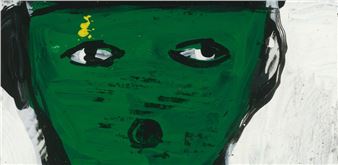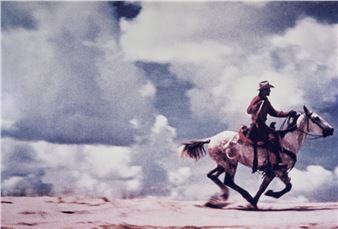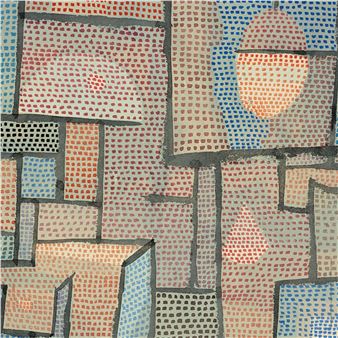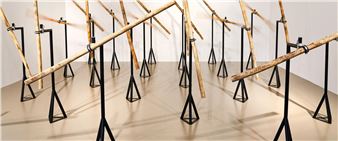The Missing Circle
The Missing Circle is a three-year series curated by MagalГӯ Arriola, KADIST collection Regional Curator for Latin America, departing from the shared experience of death and extinction in Latin America from colonial times to the present. Consisting of a series of seminars, artist commissions, and exhibitions, The Missing Circle explores the various manifestations of death in the region from the figure of the вҖҳundead,вҖҷ as incarnated by early capitalist slave economies and forced labor to the haunting bodies of those fallen, to drug wars that certain countries have waged on their own citizens. Like a fable providing an allegorical approach to the Latin American social and political scenery, The Missing Circle revisits particular episodes and events in the regionвҖҷs history to explore the role that counted corpses and unaccounted souls play in the world of the livingвҖ”not only as casualties of institutionalized violence and bare life but also as emancipating agents at the heart of new political formations.
By convening historical individuals, fictional characters, tangible facts, and mythical stories, the project draws a space in which temporary markers acquire a different morphology and reveal the connective pathways. For the anthropologist Michael Taussig, the inscription of Latin American political history into social landscapes has frequently outlined a вҖҳspace of deathвҖҷ that вҖңвҖҰhas a long and rich culture. It is where the social imagination has populated its metamorphosing images of evil and the underworld.вҖқ As a consequence of imperial politics and colonial exploitation, the space of death is a heterotopian expanse where terrestrial beings and supernatural creatures live, die and are reborn. It is also where, as suggested by Julio CortГЎzar, a вҖҳmissing circleвҖҷ in DanteвҖҷs infernos prevails, one that was created by our ruling classes.
Initiated by KADIST collection, The Missing Circle develops through partnerships with institutions across Latin America, starting with a three-day seminar in Tecoh, Yucatan, entitled вҖңFables of the UndeadвҖ“An Allegorical Story of Latin America.вҖқ Co-produced with TransformaciГіn Arte y EducaciГіn (TAE Foundation) and the support of Patronato Arte ContemporГЎneo (PAC), participant-led lectures, performances, and discussions focused on the figure of the zombi in Haitian and Brazilian cultures, as well as the instrumental role it played in the first slave revolts.
Following the Tecoh Seminar, a new work by Carla Zaccagnini was co-commissioned and co-presented with Museo Experimental El Eco in Mexico City. Titled вҖңEl presente, maГұanaвҖқ the work explored the relationship between modern Brazil and its colonial past. The second commission, вҖңEl guardiГЎn del bosqueвҖқ and вҖңEl mensajero del bosque sumergidoвҖқ by Naufus RamГӯrez Figueroa was presented as a two-part exhibition in collaboration with Proyectos Ultravioleta in Guatemala City and Centro de FormaciГіn de la CooperaciГіn EspaГұola in AntiguaвҖ”featuring a new body of work based on the artistвҖҷs research into the historical memory of the ruins of Kawinal in Guatemala, and its relationship to the countryвҖҷs political reality and armed conflict.
In the second year of The Missing Circle a four-day seminar вҖңDeath Without Bodies, Bodies Without LifeвҖқ was organized in the Atacama Desert and TarapacГЎ Region of Chile. Co-produced with Universidad de TarapacГЎ and scholar Jorge Pavez Ojeda with support from Aimee Labarrere de Servitje and PAC, multiple site visits, walking tours, and presentations taking place throughout the desert focused on certain social and political events in Chile that have been inscribed into the landscape and preserved by the territoryвҖҷs geography. Dialogue elucidated the numbers of bodies without life and deaths without a body, and how inert, mutilated, missing or mummified bodies can play a role recuperating agency and speech.
The TarapacГЎ Seminar also served as a foundation for a new work by artist duo Rometti Costales entitled вҖңCanciГіn para un fГіsil canoro (Song for a Chanting Fossil)вҖқ co-commissioned and co-presented with Museo de la Solidaridad Salvador Allende (MSSA) in Santiago. Concluding the series of new commissions for The Missing Circle, the artists developed an installation intervening and departing from the history of the building that houses MSSA and associating it with layers of ChileвҖҷs history and processes of fossilization that have taken place in areas of the Atacama Desert, the territory that has been the stage for several episodes in the countryвҖҷs economic and political past.

Recommended for you
The Missing Circle is a three-year series curated by MagalГӯ Arriola, KADIST collection Regional Curator for Latin America, departing from the shared experience of death and extinction in Latin America from colonial times to the present. Consisting of a series of seminars, artist commissions, and exhibitions, The Missing Circle explores the various manifestations of death in the region from the figure of the вҖҳundead,вҖҷ as incarnated by early capitalist slave economies and forced labor to the haunting bodies of those fallen, to drug wars that certain countries have waged on their own citizens. Like a fable providing an allegorical approach to the Latin American social and political scenery, The Missing Circle revisits particular episodes and events in the regionвҖҷs history to explore the role that counted corpses and unaccounted souls play in the world of the livingвҖ”not only as casualties of institutionalized violence and bare life but also as emancipating agents at the heart of new political formations.
By convening historical individuals, fictional characters, tangible facts, and mythical stories, the project draws a space in which temporary markers acquire a different morphology and reveal the connective pathways. For the anthropologist Michael Taussig, the inscription of Latin American political history into social landscapes has frequently outlined a вҖҳspace of deathвҖҷ that вҖңвҖҰhas a long and rich culture. It is where the social imagination has populated its metamorphosing images of evil and the underworld.вҖқ As a consequence of imperial politics and colonial exploitation, the space of death is a heterotopian expanse where terrestrial beings and supernatural creatures live, die and are reborn. It is also where, as suggested by Julio CortГЎzar, a вҖҳmissing circleвҖҷ in DanteвҖҷs infernos prevails, one that was created by our ruling classes.
Initiated by KADIST collection, The Missing Circle develops through partnerships with institutions across Latin America, starting with a three-day seminar in Tecoh, Yucatan, entitled вҖңFables of the UndeadвҖ“An Allegorical Story of Latin America.вҖқ Co-produced with TransformaciГіn Arte y EducaciГіn (TAE Foundation) and the support of Patronato Arte ContemporГЎneo (PAC), participant-led lectures, performances, and discussions focused on the figure of the zombi in Haitian and Brazilian cultures, as well as the instrumental role it played in the first slave revolts.
Following the Tecoh Seminar, a new work by Carla Zaccagnini was co-commissioned and co-presented with Museo Experimental El Eco in Mexico City. Titled вҖңEl presente, maГұanaвҖқ the work explored the relationship between modern Brazil and its colonial past. The second commission, вҖңEl guardiГЎn del bosqueвҖқ and вҖңEl mensajero del bosque sumergidoвҖқ by Naufus RamГӯrez Figueroa was presented as a two-part exhibition in collaboration with Proyectos Ultravioleta in Guatemala City and Centro de FormaciГіn de la CooperaciГіn EspaГұola in AntiguaвҖ”featuring a new body of work based on the artistвҖҷs research into the historical memory of the ruins of Kawinal in Guatemala, and its relationship to the countryвҖҷs political reality and armed conflict.
In the second year of The Missing Circle a four-day seminar вҖңDeath Without Bodies, Bodies Without LifeвҖқ was organized in the Atacama Desert and TarapacГЎ Region of Chile. Co-produced with Universidad de TarapacГЎ and scholar Jorge Pavez Ojeda with support from Aimee Labarrere de Servitje and PAC, multiple site visits, walking tours, and presentations taking place throughout the desert focused on certain social and political events in Chile that have been inscribed into the landscape and preserved by the territoryвҖҷs geography. Dialogue elucidated the numbers of bodies without life and deaths without a body, and how inert, mutilated, missing or mummified bodies can play a role recuperating agency and speech.
The TarapacГЎ Seminar also served as a foundation for a new work by artist duo Rometti Costales entitled вҖңCanciГіn para un fГіsil canoro (Song for a Chanting Fossil)вҖқ co-commissioned and co-presented with Museo de la Solidaridad Salvador Allende (MSSA) in Santiago. Concluding the series of new commissions for The Missing Circle, the artists developed an installation intervening and departing from the history of the building that houses MSSA and associating it with layers of ChileвҖҷs history and processes of fossilization that have taken place in areas of the Atacama Desert, the territory that has been the stage for several episodes in the countryвҖҷs economic and political past.
Artists on show
- Alfredo López Morales
- Antonio Reynoso
- Beatriz González
- Carla Zaccagnini
- Carlos Amorales
- Cildo Meireles
- Cristóbal Lehyt
- Edgardo Aragón
- Eustaquio Neves
- Fredi Casco
- Guillermo Kuitca
- Jesse Lerner
- Jonathas Andrade
- Joscelyn Gardner
- León Ferrari
- Miguel Covarrubias
- Naufus Ramirez Figueroa
- Noé Martínez
- Nohemí Pérez
- Pablo Swezey
- Pavel Aguilar
- Pierre Huyghe
- Rometti Costales
- Sam Durant
Contact details


 ARTISTS
ARTISTS















